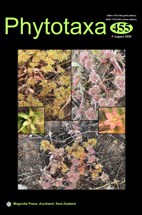Abstract
Two strains, representing trichocladium-like species, were collected from a freshwater lake in Guizhou Province, China. Based on the morphological characters, they were well identified as Trichocladium constrictum who lacked molecular data. In the phylogenetic analyses of combined LSU, ITS and SSU sequence data, the collections cluster together with Cirrenalia iberica within Halosphaeriaceae but formed a distinct clade to the type of Cirrenalia (Halosphaeriaceae) and Trichocladium (Chaetomiaceae). The significant long conidiophores of Trichocladium constrictum differ from those of other Trichocladium species. The straight conidia of Cirrenalia iberica is distinguished from curved conidia of other Cirrenalia species. In line with the morphological characters and phylogenetic analyses, Cucurbitinus gen. nov. is proposed to accommodate Trichocladium constrictum and Cirrenalia iberica as Cucurbitinus constrictus comb. nov. and Cucurbitinus ibericus comb. nov. Descriptions and illustrations of the new taxa are provided with discussion of the reclassification.

